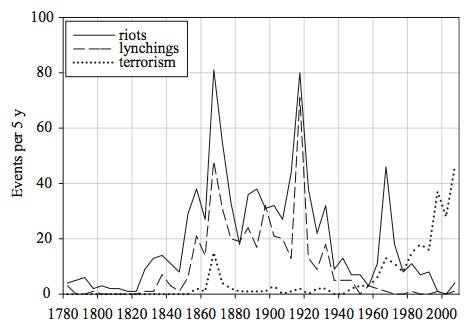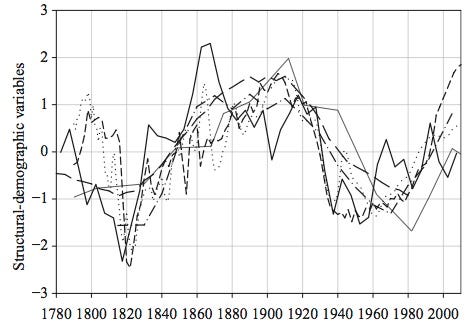Both Nature and New Scientist recently covered the work of Peter Turchin, who suggests, based on prior trends, that the US is in for a new period of political instability peaking around 2020. He finds that historically US instability has peaked about every fifty years:

He also found this 50 years cycle in Roman and French history, but not in Chinese history. This evidence seems sufficient to mildly raise my expectation of instability at that time, relative to what I would have otherwise thought. Turchin also sees a 150 year cycle in six (de-trended) parameters that suggest instability:

This suggests a US peak in the decades surrounding 2040. Other civilizations have had such long waves, but with widely varying periods. This also mildly raises my expectation of instability in that period.
Even so, the strongest trend we see is a long term worldwide decline in such things. So my strongest expectation is for a continued long term decline in instability. But yes, let’s watch out for the US in 2020.




Well, Turchin got this one bang on the money.
This is somewhat compelling but also somewhat lacking. What's the scoop on the nearly hundred years quiet from 1780 to 1870? Also none of these incidences were widespread. In 1870 it was farmers. In 1920 it was bank rushes and in 1970 it was the civil rights movement. The most interesting part to me is how lynchings (sadly) directly jumped with riots in the 19th and 20th centuries. Now they are all but gone. Are we going to see a new violent expression of unrest? Also terrorism is a relative newcomer and is currently the biggest mover. However, our current government is far more vigilant on this front than any of the other subjects on the graph. My conclusion is that this study mostly shows us the direct relation between economic trouble and social unrest, which is good. I'm not seeing it as too useful a predictive model. I would definitely say that with our current economic troubles and increasingly polarized social climate the US may see some strife.